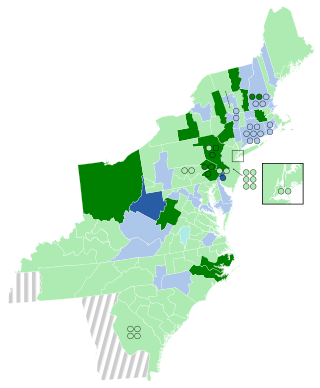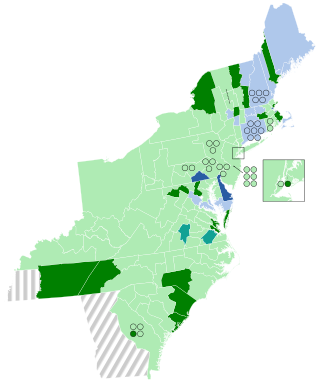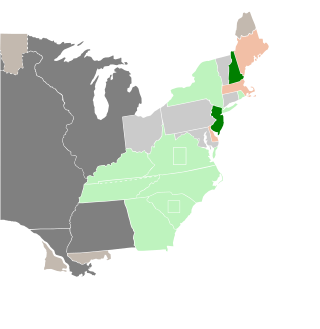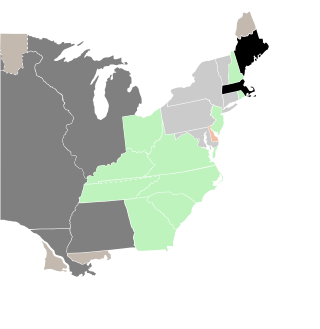| Elections in Virginia |
|---|
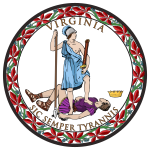 |
Virginia increased its apportionment from 19 to 22 seats after the 1800 census. Virginia's congressional delegation remained the largest of any state, but would lose this distinction permanently after the 1810 United States census. Elections were held over three days in April 1803.
Contents
| District | Incumbent | Party | First elected | Result | Candidates |
|---|---|---|---|---|---|
| Virginia 1 | George Jackson Redistricted from the 3rd district | Democratic-Republican | 1795 1797 (Lost) 1799 | Incumbent retired. New member (incumbent's son) elected. Democratic-Republican hold. | √ John G. Jackson [lower-alpha 1] (Democratic-Republican) Thomas Wilson (Federalist) |
| Virginia 2 | None (District created) | New seat. New member elected. Federalist gain. | √ James Stephenson (Federalist) 53.6% Osborn Sprigg (Democratic-Republican) 46.4% | ||
| Virginia 3 | John Smith Redistricted from the 1st district | Democratic-Republican | 1801 | Incumbent re-elected. | √ John Smith (Democratic-Republican) 89.9% Joseph Sexton (Democratic-Republican) 10.1% |
| Virginia 4 | David Holmes Redistricted from the 2nd district | Democratic-Republican | 1797 | Incumbent re-elected. | √ David Holmes [lower-alpha 1] (Democratic-Republican) Isaac Van Meter (Federalist) |
| Virginia 5 | None (District created) | New seat. New member elected. Federalist gain. Results were subsequently challenged and overturned. [lower-alpha 2] | √ Thomas Lewis Jr. (Federalist) 44.4% Andrew Moore (Democratic-Republican) 36.8% John Woodward (Federalist) 18.7% | ||
| Virginia 6 | Abram Trigg Redistricted from the 4th district | Democratic-Republican | 1797 | Incumbent re-elected. | √ Abram Trigg [lower-alpha 1] (Democratic-Republican) |
| Virginia 7 | Richard Brent Redistricted from the 17th district | Democratic-Republican | 1801 | Incumbent lost re-election. New member elected. Federalist gain. | √ Joseph Lewis Jr. (Federalist) 56.5% Richard Brent (Democratic-Republican) 43.5% |
| Virginia 8 | None (District created) | New seat. New member elected. Democratic-Republican gain. | √ Walter Jones [lower-alpha 1] [lower-alpha 3] (Democratic-Republican) James Ball (Federalist) | ||
| Virginia 9 | Philip R. Thompson Redistricted from the 18th district | Democratic-Republican | 1793 | Incumbent re-elected. | √ Philip R. Thompson [lower-alpha 1] (Democratic-Republican) |
| Virginia 10 | John Dawson Redistricted from the 15th district | Democratic-Republican | 1797 | Incumbent re-elected. | √ John Dawson [lower-alpha 1] (Democratic-Republican) William I. Callis (Federalist) |
| Virginia 11 | Anthony New Redistricted from the 16th district | Democratic-Republican | 1793 | Incumbent re-elected. | √ Anthony New (Democratic-Republican) 71.4% John Taylor (Federalist) 28.6% |
| Virginia 12 | None (District created) | New seat. New member elected. Federalist gain. | √ Thomas Griffin (Federalist) 50.8% Burwell Bassett (Democratic-Republican) 49.2% | ||
| Virginia 13 | John J. Trigg Redistricted from the 5th district | Democratic-Republican | 1797 | Incumbent re-elected. | √ John J. Trigg [lower-alpha 1] (Democratic-Republican) |
| Virginia 14 | Matthew Clay Redistricted from the 6th district | Democratic-Republican | 1797 | Incumbent re-elected. | √ Matthew Clay (Democratic-Republican) 88.9% James Hurt (Federalist) 11.1% |
| Virginia 15 | John Randolph Redistricted from the 7th district | Democratic-Republican | 1799 | Incumbent re-elected. | √ John Randolph [lower-alpha 1] (Democratic-Republican) Paul Carrington (Federalist) Abraham B. Venable (Democratic-Republican) Ischaxner Woodson |
| Virginia 16 | William B. Giles Redistricted from the 9th district | Democratic-Republican | 1790 (Special) 1798 (Resigned) 1801 | Incumbent retired. New member elected. Democratic-Republican hold. | √ John W. Eppes [lower-alpha 1] (Democratic-Republican) |
| Virginia 17 | Thomas Claiborne Redistricted from the 8th district | Democratic-Republican | 1793 1801 | Incumbent re-elected. | √ Thomas Claiborne (Democratic-Republican) 51.3% Richard Field (Federalist) 48.7% |
| Virginia 18 | None (District created) | New seat. New member elected. Democratic-Republican gain. | √ Peterson Goodwyn (Democratic-Republican) 66.9% James Jones (Federalist) 33.1% | ||
| Virginia 19 | Edwin Gray Redistricted from the 10th district | Democratic-Republican | 1799 | Incumbent re-elected. | √ Edwin Gray [lower-alpha 1] (Democratic-Republican) |
| Virginia 20 | Thomas Newton Jr. Redistricted from the 11th district | Democratic-Republican | 1799 | Incumbent re-elected. | √ Thomas Newton Jr. [lower-alpha 1] (Democratic-Republican) |
| Virginia 21 | Samuel J. Cabell Redistricted from the 14th district | Democratic-Republican | 1795 | Incumbent lost re-election. New member elected. Democratic-Republican hold. | √ Thomas M. Randolph (Democratic-Republican) 50.4% Samuel J. Cabell (Democratic-Republican) 49.6% |
| Virginia 22 | John Clopton Redistricted from the 13th district | Democratic-Republican | 1801 | Incumbent re-elected. | √ John Clopton [lower-alpha 1] (Democratic-Republican) James Rind (Federalist) |



